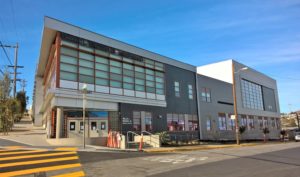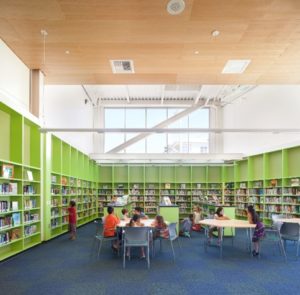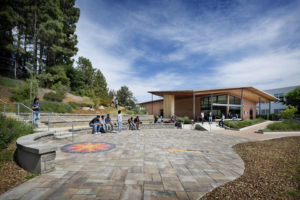Six exemplary individuals, design teams and school districts were honored with ZNE Schools Leadership Awards for their innovation and leadership in driving a new zero net energy (ZNE) standard for school environments. ZNE buildings represent high performance buildings that combine energy efficiency and renewable resources to produce at least as much energy as they consume annually, and California is leading the nation in the transformation of K-12 and community colleges to ZNE performance.
2017 Award Winners
VISIONARY DISTRICTS
Districts that have utilized policies or plans that results in larger scale advancement of zero energy buildings.

San Francisco Unified School District
Motivated by the California State Architect’s 7x7x7: Design Energy Water challenge, San Francisco Unified School District (SFUSD) has completely transformed the process by which it designs, constructs, and modernizes its buildings in order to achieve a carbon neutral district by 2040. New buildings must achieve ZNE-ready status, buildings to be modernized are assessed to identify a pathway to ZNE over two bond cycles, and all facilities and deferred maintenance projects must adhere to a strict set of guidelines to ensure compliance with ZNE goals. In order to achieve a 50% reduction in natural gas usage by 2030, SFUSD is working with the San Francisco Public Utilities Commission to replace existing gas boilers with heat pumps and install PV panels on schools across the city. In addition, goals for procuring electric and renewably-fueled vehicles will expand carbon neutral efforts to the district’s vehicle fleet.
SFUSD is an active participant in the Department of Energy Zero Energy Schools Accelerator program and enthusiastically shares the details of its strategy with other districts in order to demonstrate that carbon neutral schools can be achieved at no, or little, additional cost. Since 2008-10, SFUSD has been able to reduce its EUI by 22% to 35 kBtu/sqft/year, its natural gas use by 28%, and its water use by almost 30%.
Garden Grove Unified School District
Garden Grove Unified School District (GGUSD) has recently become a regional leader in ZNE. Its leadership may be surprising to those who know that GGUSD is a large, low-income school district with limited facilities budgets. Although the district is ranked in the lowest 20% for household income in California, its students’ test scores are in the top 20% in the state.
Through California’s Prop 39 program GGUSD was informed about the cost-effective benefits of energy conservation measures and initiated the district’s first step toward becoming a ZNE leader. In 2013, GGUSD received an allocation of an estimated $11 million in Prop 39 funds for energy conservation measures from the state, as well as $500 million in bond funds that the district issued for its first modernization program in decades. When the district learned that the California Public Utilities Commission was soliciting projects for its Proposition 39 ZNE for Schools pilot program that would provide additional funding for ZNE measures, GGUSD proposed two different retrofit projects, which were accepted in Round 1 and Round 2 of the pilot. One ZNE project is a high school science building, which will become a living laboratory for students, and the other project is an intermediate school’s multipurpose building, which includes a central kitchen that serves 5,000 meals per day.
GGUSD is a low-income district with a culture and emphasis on financial thrift that led it toward ZNE solutions. GGUSD’s leadership shows that, under the right conditions, ZNE can make financial sense for any school district.
OUTSTANDING BUILDINGS
Buildings that are ZNE verified, ZNE emerging, or ultra-low energy projects at K-12 schools and community college campuses.
ZNE EMERGING
Playa Vista Elementary School, Los Angeles Unified School District
Playa Vista Elementary School demonstrates high-level leadership in sustainability efforts through coordination of all architectural, engineering, and other associated design disciplines including energy and sustainability, that have taken place throughout each design and construction phase of this project. Efforts involving ultra-low energy goal setting and implementing energy efficient strategies into this project called for ongoing stakeholder engagement. Over the course of the project, the Playa Vista design team communicated with and involved stakeholders in sustainable design and construction decisions, analyzed project progression and performance data, set ultra-low energy goals based on data findings, and developed high performance strategies to achieve project goals.
All energy and sustainability features in Playa Vista Elementary School strive to create significant impact to its students, faculty, staff members, local community members, and beyond. From the installation of renewable energy sources such as canopy photovoltaic panels that generate enough energy to cover 80% of annual energy usage, the geothermal heat exchange system, water source heat pumps, cross-ventilation design, riparian corridor as bio-filtration, native plant selection, to the reduction of heat islands; Playa Vista Elementary School is focused on pursuing educational and green technology for the benefit of the entire Playa Vista school community. The school currently operates at a gross EUI of 28 kBtu/sqft/year, and produces an EUI of 21 kBtu/sqft/year, so overall the school uses a net EUI of 7 kBtu/sqft/year.
ZNE VERIFIED
Bishop O’Dowd High School Center for Environmental Studies
 The Center for Environmental Studies (CES) is a standout project and an incredible example of how ZNE can be achieved while interweaving the building with the natural resources on site. The project is the outcome of an integrated community design process. Built in part to support the Living Lab, which itself was built by faculty, students, and community members, the design and development of the CES also involved a school-wide effort. Multiple design charrettes were held for students, faculty, administration, and parents, and their input was incorporated into the goals and design of the building. The first design charrette with the environmental science students also had the students camping out on the site and recording their findings into a combined site analysis diagram that was the basis of passive design strategies. All facets of the building design operates as a system within its surrounding ecosystem. All complexity has been removed, resulting in a building that is truly integrated with its site assets, occupants, and building mechanical, electrical, and plumbing systems. To extend the learning opportunity of the living lab building to the students and occupants, all energy use, energy production, domestic water use, and rainwater use are monitored and displayed on a building dashboard screen located on the covered patio outdoor classroom as well as accessible from the internet.
The Center for Environmental Studies (CES) is a standout project and an incredible example of how ZNE can be achieved while interweaving the building with the natural resources on site. The project is the outcome of an integrated community design process. Built in part to support the Living Lab, which itself was built by faculty, students, and community members, the design and development of the CES also involved a school-wide effort. Multiple design charrettes were held for students, faculty, administration, and parents, and their input was incorporated into the goals and design of the building. The first design charrette with the environmental science students also had the students camping out on the site and recording their findings into a combined site analysis diagram that was the basis of passive design strategies. All facets of the building design operates as a system within its surrounding ecosystem. All complexity has been removed, resulting in a building that is truly integrated with its site assets, occupants, and building mechanical, electrical, and plumbing systems. To extend the learning opportunity of the living lab building to the students and occupants, all energy use, energy production, domestic water use, and rainwater use are monitored and displayed on a building dashboard screen located on the covered patio outdoor classroom as well as accessible from the internet.
Above all, the largest impact on the environment will be through the compounding effect of awareness and education that each student and visitor will take away from their visit. In addition to educating the users and building visitors, it also serves as a great example of a simple building with simple systems in this very forgiving climate zone. The building utilizes only natural ventilation and heating. The architecture was key in making this approach work, and still deliver a thermally comfortable space. The school currently operates at a gross EUI of 18 kBtu/sqft/year and produces an EUI of 19 kBtu/sqft/year so overall the school uses a net positive EUI of -1 kBtu/sqft/year.
INDIVIDUALS & FIRMS
Individuals and firms who inspire others on the path to ZNE as well as project teams that work effectively together to achieve ZNE goals.
Alexis Karolides
Alexis Karolides’s career focus has been on promoting and leading teams to develop super-efficient buildings, both during her 15-year tenure as Principal and Green Development Team Leader at Rocky Mountain Institute and currently as Principal and Sustainability Practice Leader at Point Energy Innovations. Alexis is presently leading four ZNE school projects at Point Energy. Throughout her career, she has led deep green projects in educational, business, residential and both heavy- and high-tech industrial sectors and has spoken around the world about the human and economic benefits of a superefficient and environmentally restorative building paradigm. Alexis has led teams through integrative design and collaboration across disciplines to realize step-change reductions in energy, water use, and waste production.
An example of Alexis’ impact on a school is her role in guiding the Newcastle Elementary School ZNE retrofit project toward deeper efficiency, natural daylighting, and quieter, more comfortable learning environments; even when obstacles along the way threatened to eliminate the daylighting and some of the higher-efficiency equipment. By presenting the outstanding results of this pilot project, this project will inspire other schools and districts to follow suit. The small rural Newcastle Elementary School project is expected to achieve an EUI of 14 kBtu/sqft/year in a retrofit project, while providing 100% daylighting, views outside to trees, good air quality, quiet mechanical systems, and 100% clean renewable onsite energy.
Sonoma Academy’s AEC Team
The team, collectively and individually, are leaders in ZNE and ultra-low energy. Together, these forward thinking leaders are changing the status quo by taking an integrated approach in every step of the design-build-post-occupancy process, including educating the community, empowering stakeholders and policy makers, and challenging their own industries to target multiple benchmarks. The team included Rick Theis of Sonoma Academy; Pauline Souza, Director of Sustainability at WRNS Studio; Courtney Lorenz, Sustainability Manager at XL Construction; Hormoz Janssens, Managing Principal at Interface Engineering; David Kaneda, Principal at Integral Group.
The team started with the sustainable mission of the school, using it as a guiding principle for extension into the building system strategies and material selections. Sonoma Academy developed an ambitious agenda for their new Guild & Commons project, embracing three benchmark systems—LEED Platinum, Living Building Challenge, and Zero Net Energy. Designed to teach students about social, environmental and food justice, and to be critical thinkers and practical doers, the Guild & Commons building is a story of the region’s architecture, landscape, people, sustainability, and everyday life. From the onset, the team illustrated that sustainability is a local responsibility with schools having a leadership role in the broader urban development plan. Passive design and daylighting strategies shaped much of the design to achieve ZNE and to connect students with nature. The project is projected to achieve a net positive EUI of -4.85 kBtu/sqft/year.
